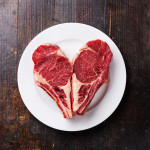By David Blyweiss, M.D., Advanced Natural Wellness
I’ve been reading the recent health headlines warning about the threat of inflammation or high homocysteine. It seems mainstream media thinks cholesterol isn’t all that significant anymore.
But, while I agree your cholesterol levels are just one factor in heart health, they’re still important. In fact, every time your total cholesterol goes up 1%, there’s a 2% to 3% increase in the risk of heart disease.
Cholesterol is a waxy substance that’s made by the body and used to make cell membranes, certain hormones, and the bile acid that helps digestion. But if your total and LDL (bad) cholesterol levels become too high, they can contribute to blockages in the arteries. That’s why you need to have your cholesterol levels checked at least once a year.
But what’s too high? Here’s a quick reference guide to help you decipher your numbers:
| Total cholesterol levels | <200 mg/dL | Desirable |
| 200-239 mg/dL | Borderline High | |
| >240 mg/dL | High | |
| LDL (bad) cholesterol levels | <100 mg/dL | Optimal |
| 100-129 mg/dL | Near Optimal | |
| 130-159 mg/dL | Borderline High | |
| 160-189 mg/dL | High | |
| >190 mg/dL | Very High | |
| HDL (good) cholesterol levels | >60 mg/dL | Optimal |
| <40 mg/dL | Too Low | |
| Triglycerides (another type of blood fat that increases the risk of heart disease) | <150 mg/dL | Normal |
| 150-199 mg/dL | Borderline High | |
| 200-499 mg/dL | High | |
| 500 mg/dL | Very High |
If your cholesterol levels are less than optimal, there are a number of ways to naturally nudge them into a healthy range without having to resort to dangerous statin drugs. And while there are dozens of ways to naturally lower your cholesterol, here are five of my favorites:
1. Fiber first. Whip up a bowl of oatmeal for breakfast to begin your day with a dose of soluble fiber. Eating oats not only lowers total cholesterol, it also helps reduce inflammation.
The World's Quickest Solution for Ending Prostate and Urinary Misery
This has recently been revealed to be one of the only real breakthroughs in prostate health.
The seeds of a strange fruit (sometimes called "Chinese Apples") hold powerful phytonutrients that are a revolution in prostate health.
In fact, UCLA and Veterans Administration research have now proved this to be true.
Not only that, but it may be the worlds quickest solution for ending prostate misery.
Simply stated, these phytonutrients represent a huge step beyond beta sitosterol, saw palmetto, and other phytosterols alone.
Simply click HERE if you want to have fast prostate relief...restful, uninterrupted sleep...no more constant "urges to go"...enhanced virility...and optimal prostate support for life.
2. Add essential fatty acids. The best source of these heart-healthy fats is fish like salmon, halibut and sardines. But since most of us don’t eat fish often enough, I recommend taking 3,000 mg of fish oil in supplemental form every day. A recent trial of 88 people with high cholesterol found that boosting omega-3s from fish oil reduced total cholesterol by 16% and LDL cholesterol by 21%.1
3. Try powerful plant sterols. These are naturally occurring plant compounds found in vegetables and legumes. Because they have a chemical structure similar to cholesterol, they can block cholesterol absorption in the intestine by more than 10%.2 As a bonus, sterols also help reign in triglycerides. Take 1.3 g of supplemental plant sterols with your largest meal every day.
4. Super boost with red yeast rice. Combined with supplemental fish oil, taking 2,400 mg of red yeast rice daily has proven just as effective as a statin drug.3 But if you opt for red yeast rice, it’s important to take a Co-Q10 supplement to prevent low levels of this energy boosting nutrient.
5. Get moving. While it’s been well established that exercise boosts HDL, experts didn’t think it affected LDL—until recently. But, while working out won’t lower your LDL, exercise—especially aerobic exercise—will make it less dangerous by transforming the riskiest type of LDL particles, those that are small and dense, into a more benign form.4 That makes the particles less dangerous, even if the overall LDL level stays the same.
References:
- Adamsson V. Effects of a healthy Nordic diet on cardiovascular risk factors in hypercholesterolaemic subjects: a randomized controlled trial (NORDIET). Journal of Internal Medicine. 2010 Sep 28. doi: 10.1111/j.1365-2796.2010.02290.x. [Epub ahead of print]
- Carr TP. Stearate-enriced plant sterol esters lower serum LDL cholesterol concentration in normo- and hpercholesterolemic adults. Journal of Nutrition. 2009;139:1445-1450.
- Becker DJ. Simvastatin vs. therapeutic lifestyle changes and supplements: randomized primary prevention trial. Mayo Clinic Proceedings. 2008;83:758-764.
- Wooten JS. Responses of LDL and HDL particle size and distribution to omega-3 fatty acid supplementation and aerobic exercise. Journal of Applied Physiology. 2009;107:794-800.






